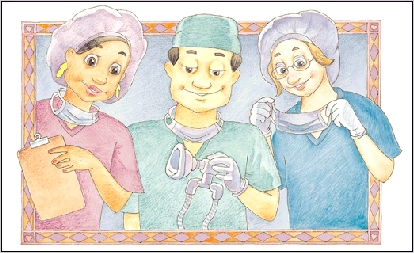Tonsil, Adenoid, and Ear Tube Surgery: Going to Surgery
Tonsil, Adenoid, and Ear Tube Surgery: Going to Surgery
Your child will be cared for by a surgical team. This team will include a surgeon, and one or more nurses, and other healthcare professionals. An anesthesiologist or nurse anesthetist will give your child medicine to make him or her fall asleep.
Going to surgery
What to expect:
Before going to surgery, your child may be given a sedative to help him or her relax.
Your child's blood pressure, breathing, oxygen level, and heart rate will be monitored during and after surgery.
The surgeon will speak with you when the operation is over. A nurse will let you know when you can see your child a short time after surgery.
Sam meets some nice people...
There are so many people at the hospital! Sam sees his healthcare providers. He also meets a sleep healthcare provider. The healthcare providers look a little silly because they are wearing hats, gloves, and masks. They all want to help Sam feel better.
Soon Sam gets on a special bed with wheels. Sam has stickers on his chest. He also has a soft clip on his finger. These things will help the healthcare providers take care of Sam.
Updated:
October 07, 2017
Sources:
Anesthesia for tonsillectomy with or without adenoidectomy in children. UpToDate, Tonsillectomy and/or adenoidectomy in children: Preoperative evaluation and care. UpToDate
Reviewed By:
Fetterman, Anne, RN, BSN,Kacker, Ashutosh, MD

